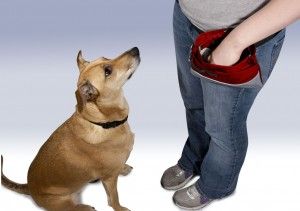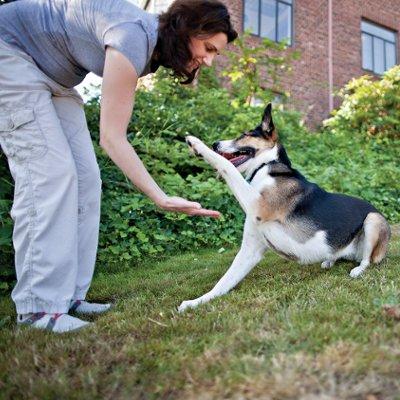By Michelle Mullins, CPDT-KA, KPA-CTP
 Michelle Mullins, CPDT-KA As a professional dog trainer I get asked one question more than any other, “What is the most important thing to train a dog to do?” My answer is usually, “It depends," because what you need your dog to know probably is not the same as what someone else needs.
Michelle Mullins, CPDT-KA As a professional dog trainer I get asked one question more than any other, “What is the most important thing to train a dog to do?” My answer is usually, “It depends," because what you need your dog to know probably is not the same as what someone else needs.
When asked to write a blog post about this subject I decided to share the things that will keep them safe, healthy and build a strong bond to you. This is certainly not a list of all the important things you can teach your dog. Ask another trainer and you will probably get a slightly different list. There are additional behaviors I teach including walk on a loose leash, sit, stay and lay down. I find the five here valuable throughout my dog’s life and help me establish some basic behaviors I use in many situations. You can also build on these to train other behaviors.
1) Look at Me/Attention
This means having your dog voluntarily give his attention to you. If you don’t have his attention it’s pretty much impossible to train anything so I always start with this one. Hold food in your hands out of your dog’s reach. Your dog will focus on the food and may try to jump to get it. Just ignore the behavior (but do not let him get the food) until he looks at you (makes eye contact). As soon as he makes eye contact, click or mark the eye contact with a clicker or a word(like “Yes”) and give him a piece of the food. Repeat a few times. Make sure you click/mark the second his eyes meet yours. After 3 days of clicking the second his eyes meet yours, have him hold eye contact for 2 seconds, then click and treat. You can slowly increase time he is holding eye contact, working up to 10-20 seconds eventually. Once you have the behavior established you can add a cue such as “Look."
2) Touch a Target
 Establishing a target behavior will aid in teaching recall, loose leash walking and to move your dog into a certain positions, like sit or down. It can be used to substitute for food lure where you might be tempted to use one to get the dog in a particular position.
Establishing a target behavior will aid in teaching recall, loose leash walking and to move your dog into a certain positions, like sit or down. It can be used to substitute for food lure where you might be tempted to use one to get the dog in a particular position.
You can teach your dog to touch his nose to your hand or, if he is a smaller dog, a long wooden spoon or target stick as this limits the amount of bending you will need to do. To teach this target, place your hand about 4 or 5 inches in front of your dog’s nose. Most dogs will sniff your hand. When your dog’s nose touches your hand, click/mark and give a treat. Repeat this several times. If your dog shows little interest in touching your hand practice a couple times with a treat in the target hand to get the game started. As the dog begins to quickly touch your hand for the click/mark and treat, begin moving your hand slightly farther away and to different heights and sides. Each time your dog touches the target, mark and reward with a treat. If the dog is slow to respond (more than three to four seconds), remove your hand target for a couple seconds and offer it again a little closer.
Focus on getting several quick repetitions in a training session.
3) Come When Called
The following are some tips and fun training games to help your dog learn coming to you is the most exciting thing on earth!
- Make your recall signal very unique and save it for when you need it- only when you are prepared to reward it with your dog's favorite reward (like a tidbit of steak or a game of fetch with the tennis ball) at first.
- Practice recalls when you are feeding the dog dinner, getting ready to go on a walk, etc. things your dog likes to do. This builds a history of rewards which strengthens the behavior of coming to you.
- Make sure that you are going to be more interesting than the environment when you are working on the recall.
- Keep treats (small jars of meat baby food work well) hidden around in each room and practice often.
- Don’t call your dog for things he/she doesn’t enjoy – baths, trips to the vet, nail trims, etc., that weakens the behavior. No dog wants to come to you when everything you call him for is no fun!
- While learning a good recall, if you think there is a very good chance your dog will not come to you – don't call him (go get him instead). Otherwise the word "come" will mean "come when you aren't doing something you think is more fun!"
- Begin in the house and increase distractions gradually.
Training Games for teaching your dog to come when called.
o Dinner! This is as simple as it gets. We often miss this as an opportunity to build a strong recall. Call your dog and then feed him.
o Treat & Dash – Soon your dog will love running to you! Remember, the best way to get your dog to come to you is to run away - not come toward and chase him.
- Have dog sit or wait - walk across the room – drop a tasty treat on the floor and call your dog to come at the same time
- As he runs toward you and the treat, run to the other side of the room
- As your dog is eating the treat call dog to come and drop another treat, run back to the 1st side of the room and repeat
o Hide and Seek- Simply hide from your dog and reward him enthusiastically when he finds you. Surprise him with an amazing food treat or some play time! Dog's love to hunt and this exercise allows him to do a "fun dog thing" and learn to come to you at the same time!
o Double-Good-Guy-Game- This exercise requires two people, a distracter and a trainer. The distracter holds the dog's favorite toy or treat, and the trainer carries hidden treats. The distracter begins feeding the dog treats while the trainer walks a few feet away and begins calls the dog. As soon as the trainer calls the distracter freezes, stops giving treats and/or the toy disappears and ignores the dog. Most dogs will continue attempts to solicit treats from the distracter, but the distracter must continue to ignore the dog. The dog will eventually turn its attention to the trainer, and the trainer says “Yes!” when the dog turns toward them. When the dog reaches the trainer, give a hidden treat. The end result of this exercise is a dog that will recall to the owner even with a delicious distraction present.
4) Leave It/Drop It or Trade It
 Teaching your dog to leave an object alone or to drop it if he already has it is extremely important for the safety of both the dog and the people who live with him. Dogs naturally want to investigate items dropped on the floor, food on the counter, trash on the street, etc. Many of these situations could present danger to the dog for example a pill dropped and scarfed up by your dog could poison him. In the other instance, grabbing something a dog has, like your best shoes and snatching them away could prompt your dog to guard the item he finds so valuable and snarl or snap. These are two separate behaviors but they are related in that they are both safe ways to keep your dog from things that are inappropriate for him to have.
Teaching your dog to leave an object alone or to drop it if he already has it is extremely important for the safety of both the dog and the people who live with him. Dogs naturally want to investigate items dropped on the floor, food on the counter, trash on the street, etc. Many of these situations could present danger to the dog for example a pill dropped and scarfed up by your dog could poison him. In the other instance, grabbing something a dog has, like your best shoes and snatching them away could prompt your dog to guard the item he finds so valuable and snarl or snap. These are two separate behaviors but they are related in that they are both safe ways to keep your dog from things that are inappropriate for him to have.
Leave it is teaching your dog to not grab or take something. Fill your hand with treats and make a fist on the floor (or in the air). Let your dog investigate your hand. He may paw and lick and even push your hand around. Do not let him have any treats for doing that. The instant he removes his head and paws from your hand click/mark and treat him from your other hand or a pocket where you have some additional treats. Work up to having your hand slightly open over treats on floor, and finally progress to dropping food to the floor. Don’t rush the process. Focus on making steady progress. Once he eagerly ignores the treats you can start to add the cue, “Leave It."
Sometimes your dog may get something you don’t want him to have before you can even react or when you aren’t watching. I teach the version of Drop It called Trade It. Safety first! – Never pull something out of your dog’s mouth or remove forcibly from his possession if you can avoid it. Teach a reliable drop it/trade to ensure safety. One great way is to teach a dog the proper rules of tug. You will need an appropriate toy and some very tasty treats in your bait bag or pocket.
- The game only starts we you initiate it by asking the dog to sit and then offering the toy.
- Once your dog is tugging with you for 20 to 30 seconds cue the dog to “Drop” or “Trade” and follow the cue with an offer of a tasty treat. This is the trade!
- Let them finish the treat
- Reengage him by offering the toy
- Repeat the play and trade every 20 to 30 seconds during the training session
- Practice these rules – be consistent and patient.
Once your dog learns the game “Drop” or “Trade” becomes great fun. The first time you ask him to drop something like your cell phone and he does, run, don’t walk, to the kitchen and give him a very nice tasty reward.
5) Let Me Handle You
Teaching your dog to accept handling can go a long way in ensuring proper healthcare and grooming is easy to do and safe. By associating being handled with some tasty treats and following it with some fun playtime your dog can learn to accept the type of handling needed for veterinary care and grooming. I like to start by gently petting the animal while feeding a few treats. In later sessions I focus on touching the ear and giving treats a few times. The next session I might work on handling the leg and foot while making it a fun experience. Work on handling different areas each session keeping the sessions short and gentle. Once your dog learns this can be fun start moving the sessions to different areas like the bathroom or car.
Speak with your veterinary staff and groomer about how you are working to make handling a comfortable experience for your dog. I’m sure they will be glad to help as it will make their jobs much easier.
So these are my top five things to train your dog. What are your top things and why?




